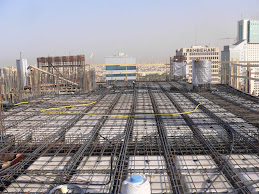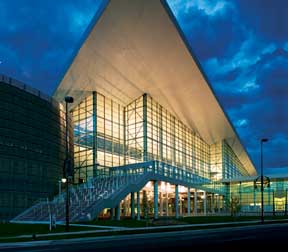

Curtain wall is a term used to describe a building façade which does not carry any dead load from the building other than its own dead load, and one which transfers the horizontal loads (wind loads) that are incident upon it. These loads are transferred to the main building structure through connections at floors or columns of the building. A curtain wall is designed to resist air and water infiltration, wind forces acting on the building, seismic forces (usually only those imposed by the inertia of the curtain wall), and its own dead load forces.
Curtain walls differ from storefront systems in that they are designed to span multiple floors, and take into consideration design requirements such as: thermal expansion and contraction; building sway and movement; water diversion; and thermal efficiency for cost-effective heating, cooling, and lighting in the building.
The first curtain walls were made with steel mullions, and the plate glass was attached to the mullions with asbestos or fiberglass modified glazing compound. Eventually silicone sealants or glazing tape were substituted. Some designs included an outer cap to hold the glass in place and to protect the integrity of the seals. The first curtain wall installed in New York City was this type of construction. Earlier modernist examples are the Bauhaus in Dessau and the Hallidie Building in San Francisco. The 1970’s began the widespread use of aluminum extrusions for mullions. Aluminum offers the unique advantage of being able to be easily extruded into nearly any shape required for design and aesthetic purposes. Today, the design complexity and shapes available are nearly limitless. Custom shapes can be designed and manufactured with relative ease.
The vast majority of curtain walls are installed long pieces (referred to as sticks) between floors vertically and between vertical members horizontally. Framing members may be fabricated in a shop environment, but all installation and glazing is typically performed at the jobsite.
Unitized systems
Unitized curtain walls entail factory fabrication and assembly of panels and may include factory glazing. These completed units are hung on the building structure to form the building enclosure. Unitized curtain wall has the advantages of: speed; lower field installation costs; and quality control within an interior climate controlled environment. The economic benefits are typically realized on large projects or in areas of high field labor rates.
A common feature in curtain wall technology, the rainscreen principle theorizes that equilibrium of air pressure between the outside and inside of the "rainscreen" prevents water penetration into the building itself. For example the glass is captured between an inner and an outer gasket in a space called the glazing rebate. The glazing rebate is ventilated to the exterior so that the pressure on the inner and outer sides of the exterior gasket is the same. When the pressure is equal across this gasket water cannot be drawn through joints or defects in the gasket.
Dead load
Dead load is defined as the weight of structural elements and the permanent features on the structure. In the case of curtain walls, this load is made up of the weight of the mullions, anchors, and other structural components of the curtain wall, as well as the weight of the infill material. Additional dead loads imposed on the curtain wall, such as sunshades, must be accounted for in the design of the curtain wall components and anchors.
Snow loads and live loads are not typically an issue in curtain walls, since curtain walls are designed to be vertical or slightly inclined. If the slope of a wall exceeds 20 degrees or so, these loads may need to be considered.
Accidental explosions and terrorist threats have brought on increased concern for the fragility of a curtain wall system in relation to blast loads. The bombing of the Alfred P. Murrah Federal Building in Oklahoma City, Oklahoma, has spawned much of the current research and mandates in regards to building response to blast loads. Currently, all new federal buildings in the U.S., and all U.S. embassies built on foreign soil, must have some provision for resistance to bomb blasts.
Blast resistant glazing consists of laminated glass, which is meant to break but not separate from the mullions. Similar technology is used in hurricane-prone areas for the protection from wind-borne debris.
Relative to other building components, aluminum has a high heat transfer coefficient, meaning that aluminum is a very good conductor of heat. This translates into high heat loss through aluminum curtain wall mullions. There are several ways to compensate for this heat loss, the most common way being the addition of thermal breaks. Thermal breaks are barriers between exterior metal and interior metal, usually made of polyvinyl chloride (PVC). These breaks provide a significant decrease in the thermal conductivity of the curtain wall. However, since the thermal break interrupts the aluminum mullion, the overall moment of inertia of the mullion is reduced and must be accounted for in the structural analysis of the system.
Infill refers to the large panels that are inserted into the curtain wall between mullions. Infills are typically glass but may be made up of nearly any exterior building element.
Glass
The French hothouse at the Jardin des Plantes, built by Charles Rohault de Fleury from 1834 to 1836, is an early example of metal and glass curtain wall architecture.
By far the most common glazing type, glass can be of an almost infinite combination of color, thickness, and opacity. For commercial construction, the two most common thicknesses are 1/4 inch (6 mm) monolithic and 1 inch (25 mm) insulating glass. Presently, 1/4 inch glass is typically used only in spandrel areas, while insulating glass is used for the rest of the building (sometimes spandrel glass is specified as insulating glass as well). The 1 inch insulation glass is typically made up of two 1/4-inch lites of glass with a 1/2 inch (12 mm) airspace. The air inside is usually atmospheric air, but some inert gases, such as argon, may be used to offer better thermal transmittance values. In residential construction, thicknesses commonly used are 1/8 inch (3 mm) monolithic and 5/8 inch (16 mm) insulating glass. Larger thicknesses are typically employed for buildings or areas with higher thermal, relative humidity, or sound transmission requirements, such as laboratory areas or recording studios.
Glass may be used which is transparent, translucent, or opaque, or in varying degrees thereof. Transparent glass usually refers to vision glass in a curtain wall. Spandrel or vision glass may also contain translucent glass, which could be for security or aesthetic purposes. Opaque glass is used in areas to hide a column or spandrel beam or shear wall behind the curtain wall. Another method of hiding spandrel areas is through shadow box construction (providing a dark enclosed space behind the transparent or translucent glass). Shadow box construction creates a perception of depth behind the glass that is sometimes desired.
Most curtain wall glazing is fixed, meaning there is no access to the exterior of the building except through doors. However, windows or vents can be glazed into the curtain wall system as well, to provide required ventilation or operable windows. Nearly any window type can be made to fit into a curtain wall system.
Fire safety
Combustible Polystyrene insulation in point contact with sheet metal backban. Incomplete firestop in the perimeter slab edge, made of rockwool without topcaulking.
Firestopping at the "perimeter slab edge", which is a gap between the floor and the backpan of the curtain wall is essential to slow the passage of fire and combustion gases between floors. Spandrel areas must have non-combustible insulation at the interior face of the curtain wall. Some building codes require the mullion to be wrapped in heat-retarding insulation near the ceiling to prevent the mullions from melting and spreading the fire to the floor above. It is important to note that the firestop at the perimeter slab edge is considered a continuation of the fire-resistance rating of the floor slab. The curtain wall itself, however, is not ordinarily required to have a rating. This causes a quandary as Compartmentalization (fire protection) is typically based upon closed compartments to avoid fire and smoke migrations beyond each engaged compartment. A curtain wall by its very nature prevents the completion of the compartment (or envelope). The use of fire sprinklers has been shown to mitigate this matter. As such, unless the building is sprinklered, fire may still travel up the curtain wall, if the glass on the exposed floor is shattered due to fire influence, causing flames to lick up the outside of the building. Falling glass can endanger pedestrians, firefighters and firehoses below. An example of this is the First Interstate Bank Fire in Los Angeles, California. The fire here leapfrogged up the tower by shattering the glass and then consuming the aluminium skeleton holding the glass. Aluminium's melting temperature is 660°C, whereas building fires can reach 1,100°C. The melting point of aluminium is typically reached within minutes of the start of a fire. Firestops for such building joints can be qualified to UL 2079 -- Tests for Fire Resistance of Building Joint Systems. Sprinklering of each floor has a profoundly positive effect on the fire safety of buildings with curtain walls. In the case of the aforementioned fire, it was specifically the activation of the newly installed sprinkler system, which halted the advance of the fire and allowed effective suppression. Had this not occurred, the tower would have collapsed onto fire crews and into an adjacent building, while on fire. Exceptionally sound cementitious spray fireproofing also helped to delay and ultimately to avoid the possible collapse of the building, due to having the structural steel skeleton of the building reach the critical temperature, as the post-mortem fire investigation report indicated. This fire proved the positive collective effect of both active fire protection (sprinklers) and passive fire protection (fireproofing).
Fireman knock-out glazing panels are often required for venting and emergency access from the exterior. Knock-out panels are generally fully tempered glass to allow full fracturing of the panel into small pieces and relatively safe removal from the opening.
Curtain walls and perimeter sealants require maintenance to maximize service life. Perimeter sealants, properly designed and installed, have a typical service life of 10 to 15 years. Removal and replacement of perimeter sealants require meticulous surface preparation and proper detailing.
Aluminum frames are generally painted or anodized. Factory applied fluoropolymer thermoset coatings have good resistance to environmental degradation and require only periodic cleaning. Recoating with an air-dry fluoropolymer coating is possible but requires special surface preparation and is not as durable as the baked-on original coating.
Anodized aluminum frames cannot be "re-anodized" in place, but can be cleaned and protected by proprietary clear coatings to improve appearance and durability.
Exposed glazing seals and gaskets require inspection and maintenance to minimize water penetration, and to limit exposure of frame seals and insulating glass seals to wetting.









